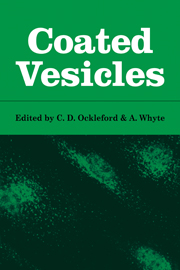Book contents
- Frontmatter
- Contents
- Preface
- Foreword
- List of contributors
- 1 Coated vesicles: a morphologically distinct subclass of endocytic vesicles
- 2 Coated vesicles in different cell types: some functional implications
- 3 Coated vesicles: their occurrence in different plant cell types
- 4 Immunoglobulin transmission in mammalian young and the involvement of coated vesicles
- 5 Coated vesicles in neurons
- 6 Coated vesicles in the oocyte
- 7 Adsorptive and passive pinocytic uptake
- 8 Coated vesicles and receptor biology
- 9 Coated secretory vesicles
- 10 Dynamic aspects of coated vesicle function
- 11 Structural aspects of coated vesicles at the molecular level
- 12 Coated vesicles in medical science
- Appendix 1 Nomenclature
- Appendix 2 References added at proof
- Author index
- Subject index
- Plate section
7 - Adsorptive and passive pinocytic uptake
Published online by Cambridge University Press: 04 August 2010
- Frontmatter
- Contents
- Preface
- Foreword
- List of contributors
- 1 Coated vesicles: a morphologically distinct subclass of endocytic vesicles
- 2 Coated vesicles in different cell types: some functional implications
- 3 Coated vesicles: their occurrence in different plant cell types
- 4 Immunoglobulin transmission in mammalian young and the involvement of coated vesicles
- 5 Coated vesicles in neurons
- 6 Coated vesicles in the oocyte
- 7 Adsorptive and passive pinocytic uptake
- 8 Coated vesicles and receptor biology
- 9 Coated secretory vesicles
- 10 Dynamic aspects of coated vesicle function
- 11 Structural aspects of coated vesicles at the molecular level
- 12 Coated vesicles in medical science
- Appendix 1 Nomenclature
- Appendix 2 References added at proof
- Author index
- Subject index
- Plate section
Summary
Introduction
Many different terms have been employed to describe different types of endocytosis, and these are listed by Chapman-Andresen (1962) and Jacques (1969), but in general endocytic phenomena fall into two broad categories, phagocytosis and pinocytosis. Phagocytosis describes the ingestion of particulate matter such as bacteria, latex beads and erythrocytes by specialised cells such as macrophages and certain unicellular organisms, whereas the more universal process of pinocytosis describes the engulfment of small droplets of extracellular fluid.
Sequence of events in pinocytosis
All types of pinocytosis show a common sequence of events (see Fig. 1).
Internalisation of plasma membrane. This may be triggered by attachment of some substance to the plasma membrane or by some other mechanism.
Translocation. Once the pinosome ‘pinches off’ from the plasma membrane, it migrates towards the perinuclear region. During this time many fusion events may occur. Initially these may be pinosome–pinosome fusions but subsequently pinosome–lysosome fusions take place, producing a secondary lysosome compartment which can also participate in the fusion sequence. The exposure of the pinosome contents to lysosomal enzymes results in the catabolism of any degradable material.
Lysosomal regression. Small molecules produced as a result of degradation escape through the lysosomal membrane, whereas any large non-biodegradable material remains trapped in the secondary lysosome compartment. Certain types of cell, especially unicellular organisms, have the ability to regurgitate material, but many mammalian cells accumulate material they cannot digest as residual bodies within the cell.
- Type
- Chapter
- Information
- Coated Vesicles , pp. 179 - 218Publisher: Cambridge University PressPrint publication year: 1980
- 18
- Cited by



